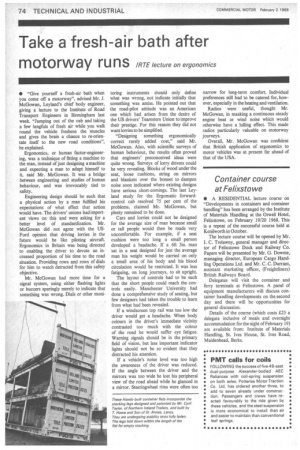Take a fresh-air bath after
Page 76

If you've noticed an error in this article please click here to report it so we can fix it.
motorway runs IRTE lecture on ergonomics
• "Give yourself a fresh-air bath when you come off a motorway", advised Mr. J. McGowan, Leyland's chief body engineer, giving a lecture to the Institute of Road Transport Engineers in Birmingham last week. "Jumping out of the cab and taking a few lungfuls of fresh air while you walk round the vehicle freshens the muscles and gives the brain a chance to re-orientate itself to the new road conditions", he explained.
Ergonomics, or human factor-engineering, was a technique of fitting a machine to the man, instead of just designing a machine and expecting a man to adapt himself to it, said Mr. McGowan. It was a bridge between engineering and studies of human behaviour, and was irrevocably tied to safety.
Engineering design should be such that a physical action by a man fulfilled his expectations of what effect that action would have. The drivers' unions had important views on this and were asking for a better level of standardization. Mr. McGowan did not agree with the USFord opinion that driving lorries in the future would be like piloting aircraft. Ergonomics in Britain was being directed to enabling the driver to devote an increased proportion of his time to the road situation. Providing rows and rows of dials for him to watch detracted from this safety objective.
Mr. McGowan had more time for a signal system, using either flashing lights or buzzers sparingly merely to indicate that something was wrong. Dials or other moni
toring instruments should only define what was wrong, not indicate initially that something was amiss. He pointed out that the road-pilot attitude was an American one which had arisen from the desire of the US drivers' Teamsters Union to improve their prestige. For this reason they did not want lorries to be simplified.
"Designing something ergonomically correct rarely added cost," said Mr. McGowan. Also, with scientific surveys of human behaviour, the results often proved that engineers' preconceived ideas were quite wrong. Surveys of lorry drivers could be very revealing. Blocks of wood under the seat, loose cushions, string on mirrors and blankets over the bonnet to dampen noise soon indicated where existing designs have serious short comings. The last Leyland study for the Ergornatic forwardcontrol cab resolved 75 per cent of the problems, claimed Mr. McGowan, but plenty remained to be done.
Cars and lorries could not be designed for the average size of man because small or tall people would then be made very uncomfortable. For example, if a seat cushion were too long a small person developed a headache. If a 6ft 3in. man sat in a seat designed for just the average man his weight would be carried on only a small area of his body and his blood circulation would be restricted. It was less fatiguing, on long journeys, to sit upright.
The layout of controls had to be such that the short people could reach the controls easily. Manchester University had done a comprehensive study of seating, but few designers had taken the trouble to learn from what had been revealed.
If a windscreen top rail was too low the driver would get a headache. When body colours in the driver's immediate vicinity contrasted too much with the colour of the road he would suffer eye fatigue. Warning signals should be in the primary field of vision, but less important indicator lights should not be so evident that they distracted his attention.
If a vehicle's noise level was too high the awareness of the driver was reduced. If the angle between the driver and the mirrors was too wide he lost his peripheral view of the road ahead while he glanced in a mirror. Steeringwheel rims were often too narrow for long-term comfort. Individual preferences still had to be catered for, however, especially in the heating and ventilation.
Radios were useful, thought Mr. McGowan, in masking a continuous steady engine beat or wind noise which would otherwise have a lulling effect. This made radios particularly valuable on motorway journeys.
Overall, Mr. McGowan was confident that British application of ergonomics to motor vehicles was at present far ahead of that of the USA.




































































































































































































